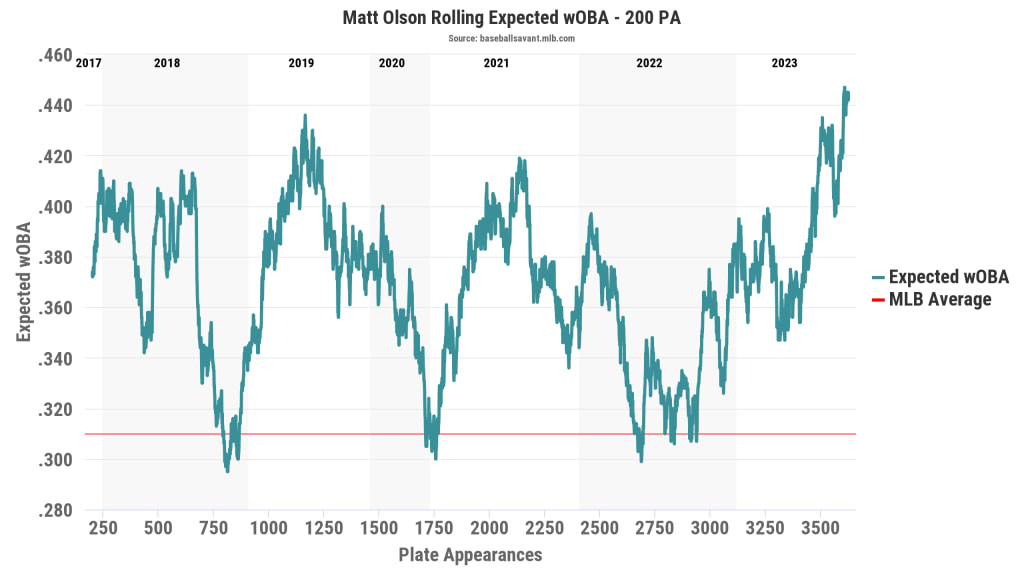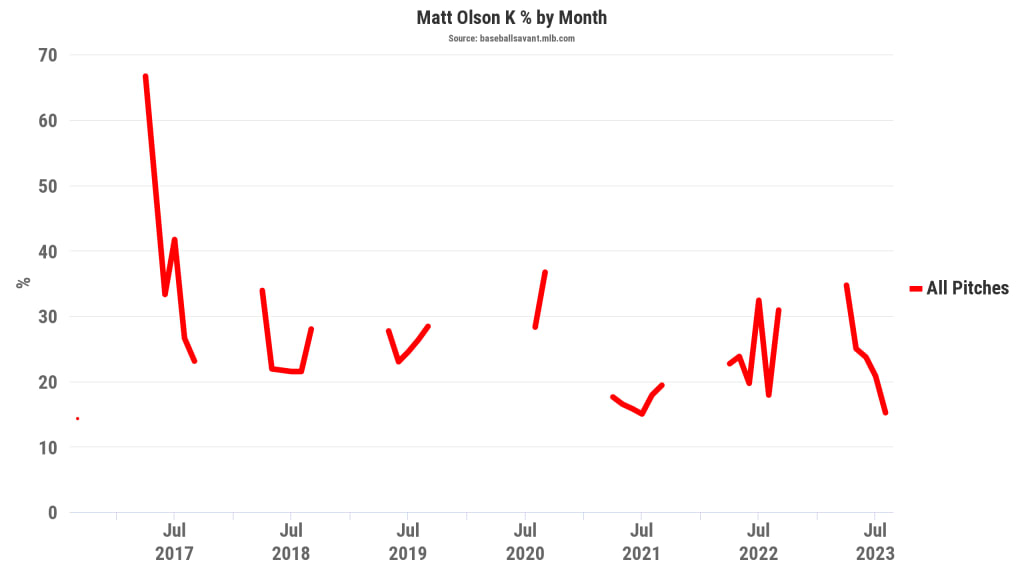Ronald Acuña Jr. isn’t the only Braves star pursuing history in 2023. While Atlanta’s superstar outfielder is on the verge of the first 30-homer, 60-steal campaign in AL/NL history and could become the fifth member of the 40/40 club, Matt Olson is marching his way toward a historic season of his own, one monstrous homer at a time.
Olson went deep again Thursday against the Pirates and is now tied with Shohei Ohtani for the MLB lead with 40 home runs on the season.
With 49 games to play, the Atlanta native needs to reach the seats 12 more times to break Andruw Jones’ single-season Braves record. He needs 20 more home runs to become the seventh player (10th occurrence) to reach the 60-homer plateau.
If that seems like a tall task, consider that Olson has crushed 22 homers in his past 45 games.
His incredible .327/.419/.792 slash in that span dwarfs the .228/.347/.483 line he put up over his first 68 games this season, as well as the .240/.325/.477 slash he posted in his first season with the Braves.
Is this merely an extended hot streak for a player who has always shown immense power potential? Maybe. But the underlying numbers suggest otherwise.
Olson may never be Freddie Freeman, the man who preceded him as Atlanta’s starting first baseman and has continued raking in Los Angeles, but he’s made meaningful strides this summer to become a more complete hitter.
In fact, this is quite literally the best stretch of Olson's career, at least in terms of expected wOBA, a Statcast metric based on quality of contact, K's and BB's.
As the graph below shows, Olson's rolling xwOBA average per 200 plate appearances reached a personal high of .445 on Aug. 6. He's never been quite that good over any other 200-PA span in his career.

Here's a look at the two key elements fueling this surge and putting Olson on a path toward baseball history.
1) Increased contact
Strikeouts have been a big part of the Olson package for much of his career. The first baseman has had only one season in which he posted a strikeout rate below 24% -- he recorded a 16.8% K-rate in 2021, his final season with the A’s, but that stands as a huge outlier compared to the rest of his career.
Olson's K-rate spiked back up to 24.3% last year, and he went down on strikes in nearly 30% of his PAs over his first 68 games this season.
However, his K-rate has plummeted to just 18.7% since June 15. Outside of 2021, his 21.4% K-rate in July was one of the lowest he's recorded in a calendar month, and he's started off August by striking out only six times in 42 PAs (14.3% K-rate).

"I feel like it's a product of putting the ball in play earlier in the count," Olson said Wednesday when asked why he thinks his K-rate is down recently. "I feel like my two-strike approach is the same as it’s always been. Nothing has changed there, but I’m getting into fewer two-strike counts."
Indeed, Olson has gotten to two strikes in 104 of his 198 PAs (52.5%) since June 15, compared to 191 of 308 (62%) previously, which means there have been fewer opportunities for the slugger to strike out.
Making better swing decisions has helped: He’s been chasing less on pitches out of the zone and offering more at in-zone pitches. Perhaps more importantly, though, he has been missing far less on those in-zone swings.
Olson entered 2023 with a career whiff rate (misses/swings) over 23% on pitches thrown in the strike zone and whiffed at a 29% clip on these pitches prior to June 15. But in his past 44 games, he has lowered that mark to 16.9%. His strikeout rate in PAs ending on in-zone pitches has dropped in kind, falling from 27.9% over his first 68 games this season to just 16.4% since June 15.
That’s not quite Luis Arraez territory, but it’s obviously a dramatic improvement. And considering the damage Olson can do when he puts the ball in play, any increase in contact quantity is a big deal for the veteran, especially on pitches in the strike zone that he can drive out of the park.
His recent results bear this out.
While Olson ranked 20th in the Majors with a .617 SLG on in-zone pitches a year ago and tied for the 24th-highest mark (.628) over his first 68 games this season, he’s slugging .896 (including 19 home runs) on in-zone pitches since June 15, MLB's second-highest figure during that span.
Highest SLG on in-zone pitches, since June 15
Min. 100 PAs ending on in-zone pitches
- Shohei Ohtani (LAA): 1.047
- Matt Olson (ATL): .896
- Luis Robert Jr. (CWS): .858
- Freddie Freeman (LAD): .770
- Corey Seager (TEX): .764
2) Improved contact quality
It didn’t seem like Olson had much room for improvement here, considering he was already among the MLB leaders in producing hard contact (95+ mph exit velocity) and barrels (batted balls with the optimal combination of exit velocity and launch angle) prior to June 15.
Somehow, though, the left-handed slugger has found another gear in the hard-hit rate arena, posting a 60.9% hard-hit rate since June 15 after recording a 55.4% figure over his first 68 games.
Meanwhile, his barrel rate has only dipped slightly, going from 19% to 18.8%. But when you factor in the increase in contact quantity stemming from his drop in K-rate, he's been producing more barrels on a per-plate-appearance basis than he was before. Over his past 44 games, 12.6% of his plate appearances have ended with a barrel, up from 10.4% through June 14 and 8.4% prior to 2023.
Similarly, 40.9% of his PAs since June 15 have ended with a hard-hit ball, up from 30.2% through June 14 and 31.7% prior to this season.
Add it all up and Olson has a .448 xwOBA since June 15, the second highest in MLB (min. 150 PAs) behind Ohtani's .486. He now has a career-high .398 xwOBA on the year, the 10th best among qualifiers, which shows what an elite hitter he's become. His OPS+ is 156, 56% better than league average and the fifth highest among qualifiers.
Again, Olson's power potential has never been in question. He burst onto the scene with 24 homers in just 59 games as a rookie in 2017 and reached the 30-mark three times before this year.
He's also had some brushes with the upper tier of big league hitters before, like when he ranked sixth in MLB with a 153 OPS+ in 2021. That said, he hasn't been able to sustain it over multiple years yet. Believe it or not, he still hasn't produced consecutive seasons with an OPS+ of 120 or higher. Compare that to Freeman, who has recorded an OPS+ of 132 or higher in every season dating back to 2013.
No matter how this season ends, Olson will need to prove he can do it again in 2024 and beyond. But at this very moment, there's no disputing that he's one of the top hitters in the game, with a real chance to reach the hallowed 60 home run plateau.
Mark Bowman contributed reporting to this story.
